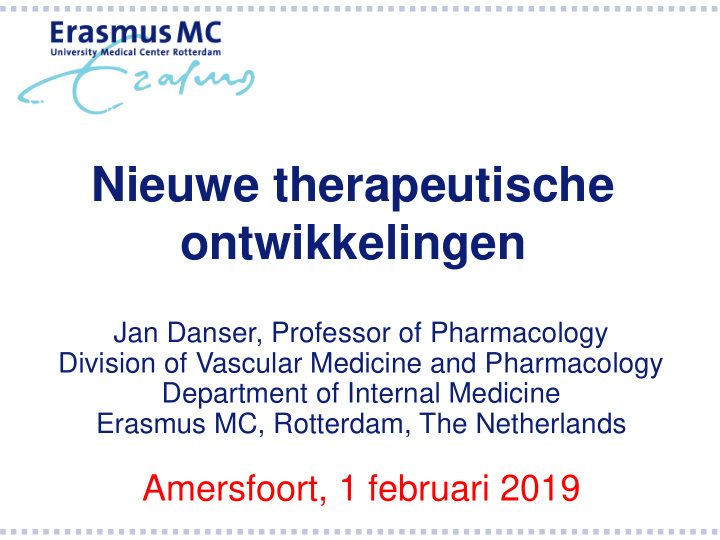



Nieuwe therapeutische ontwikkelingen Jan Danser, Professor of Pharmacology Division of Vascular Medicine and Pharmacology Department of Internal Medicine Erasmus MC, Rotterdam, The Netherlands Amersfoort, 1 februari 2019
PCSK9 breekt de LDL receptor af → minder binding LDL → LDL concentratie stijgt oplossing: zorg dat PCSK9 niet meer gemaakt wordt: siRNA targeten naar de lever 1 injectie per half jaar!
T reatment ‘’resistance’’ in hypertension • non-initiation (24%) • non-persistence (50% at 1 year) • poor execution grey: UK, black: Czech Republic Gupta et al., Hypertension 2017
Renin-angiotensin system (RAS) blockers and the negative feedback loop Angiotensinogen Renin Ang I ACE X ACEIs Negative feedback Ang II ARBs AT 1 Receptor Plasma renin Biological effects concentration Plasma renin activity
Do we need more than one RAS blocker? • the more RAS blockade, the better: > blood pressure lowering, less proteinuria, less post-MI remodelling, etc.? • ONTARGET, SUPPORT, and NEPHRON-D suggested otherwise: no further reduction in MI, stroke, and hospitalization! • yet, more side effects: hypotension and renal dysfunction (dialysis, doubling serum creatinine, hyperkalemia), although proteinuria diminished and the albumin excretion rate increased less in the combination treatment group
Angiotensinogen: antisense oligonucleotide (ASO) vs. siRNA Watts & Corey, J Pathol 2012 AGO, Argonaute
Antisense Oligonucleotide/siRNA angiotensinogen is exclusively (?) generated in the liver: how to target to this organ? • asialoglycoprotein receptor is a C- type lectin which is abundantly expressed by hepatocytes (> 0.5 million receptors/cell) • high specificity for N-acetyl- galactosamine (GalNAc)- terminated oligosaccharides • one receptor can internalize 250 GalNac-conjugated molecules during its lifetime: ideal way to transport oligonucleotide into hepatocytes!
AGT ASO: effect of liver-targeting Mullick et al., Hypertension 2017
AGT ASO: rapid suppression of liver AGT synthesis Mullick et al., Hypertension 2017
Prolonged AGT suppression with GalNac ASO 2.5, 5, 10 or 20 mg/kg Mullick et al., Hypertension 2017
Dose-dependent BP-lowering effect of GalNac ASO in SHR (2.5, 5, 10,& 20 mg/kg) Mullick et al., Hypertension 2017
GalNac AGT ASO acts in RAS blocker-resistant SHR fed 8% salt Mullick et al., Hypertension 2017
Summary and conclusions • AGT siRNA gives a similar BP AGT siRNA angiotensinogen reduction as valsartan and captopril, Renin non-inferior to ARB or ACEi angiotensin I • but with a lower dosing frequency ACE • novel treatment opportunity for apparent treatment resistant HT angiotensin II • Combination therapy has a synergistic ARB effect on BP, cardiac damage and kidney function AT 1 R • models of heart failure and Vasoconstriction Sodium retention kidney damage
Recommend
More recommend